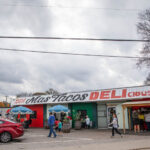Mexico is a beautiful country with a rich culture and history. However, it’s crucial for travelers to be aware of the varying safety conditions across its different states. This article provides a comprehensive overview of the safety situation in each Mexican state, utilizing a Mexico Map With States as a reference point. This information is based on the U.S. Department of State’s travel advisories.
Mexico Safety Advisory Map: A State-by-State Breakdown
The U.S. Department of State issues travel advisories for each Mexican state, ranging from “Exercise Normal Precautions” to “Do Not Travel.” These advisories are based on a thorough assessment of current safety conditions, including crime rates, kidnapping risks, and the presence of criminal organizations. Understanding these advisories and referring to a Mexico map with states is essential for planning a safe trip.
Do Not Travel:
- Colima: Due to high crime and kidnapping rates. Limited travel for U.S. government employees to Manzanillo’s tourist and port areas.
- Guerrero: Widespread crime and violence, with armed groups operating independently. No travel permitted for U.S. government employees, including to tourist areas like Acapulco.
- Michoacan: Widespread crime and kidnapping. Limited travel for U.S. government employees to specific areas and highways. Much of the Monarch Butterfly Reserve is included in the “Do Not Travel” area.
- Sinaloa: Widespread violent crime and significant presence of criminal organizations. Limited travel for U.S. government employees to Mazatlan, Los Mochis, and Topolobampo by air or sea only.
- Tamaulipas: High risk of crime and kidnapping, especially along the northern border. Limited travel for U.S. government employees to specific areas with curfews and restrictions on overland travel.
- Zacatecas: Widespread violent crime, extortion, and gang activity. Limited travel for U.S. government employees to Zacatecas City proper, with no overland travel permitted.
Reconsider Travel:
- Baja California: Crime and kidnapping risks, particularly in non-tourist areas of Tijuana. Travel restrictions for U.S. government employees in the Mexicali Valley.
- Chiapas: Risk of crime and violence throughout the state. Travel restrictions for U.S. government employees in southeastern Chiapas, specifically the municipality of Ocozocoautla.
- Chihuahua: Crime and kidnapping risks, particularly in areas frequented by tourists. Restrictions for U.S. government employees, limiting travel to specific areas and highways. Travel to Copper Canyon is prohibited for U.S. government employees.
- Guanajuato: High murder rate in the southern region due to cartel violence. U.S. government employees may not travel south of Federal Highway 45D.
- Jalisco: Crime and kidnapping risks, particularly in Guadalajara. Travel restrictions for U.S. government employees along the Jalisco-Michoacan border and certain highways.
- Morelos: Crime and kidnapping are common. No travel restrictions for U.S. government employees but increased caution advised.
- Sonora: Key location for drug and human trafficking. Widespread violent crime. Numerous travel restrictions for U.S. government employees, limiting travel to specific areas and highways.
Exercise Increased Caution:
- Aguascalientes: Risk of crime throughout the state.
- Baja California Sur: Risk of criminal activity and violence.
- Coahuila: Violent crime and gang activity in certain areas. Travel restrictions for U.S. government employees in specific municipalities along the northern border.
- Durango: Violent crime and gang activity, especially west and south of Federal Highway 45. Travel restrictions for U.S. government employees in these areas.
- Hidalgo: Risk of criminal activity and violence.
- Mexico City: Both violent and non-violent crime, particularly at night outside tourist areas.
- Mexico State: Crime and kidnapping risk, particularly outside tourist areas.
- Nayarit: Potential for criminal activity and violence.
- Nuevo Leon: Potential for criminal activity and violence.
- Oaxaca: Criminal activity and violence throughout the state. U.S. government employees have travel restrictions in the Isthmus region and on Highway 200 northwest of Pinotepa.
- Puebla: Crime and kidnapping risk throughout the state.
- Queretaro: Risk of criminal activity and violence.
- Quintana Roo: Risk of crime and violence, including in tourist destinations. Increased caution advised after dark in Cancun, Playa del Carmen, and Tulum.
- San Luis Potosi: Crime and kidnapping risks throughout the state.
- Tabasco: Risk of criminal activity and violence.
- Tlaxcala: Risk of criminal activity and violence.
- Veracruz: Increased frequency of violent crime and gang activity, especially in central and southern areas.
Exercise Normal Precautions:
- Campeche: No specific safety concerns.
- Yucatan: No specific safety concerns. Popular tourist destinations such as Chichen Itza, Merida, and Uxmal are located in this state.
Planning Your Trip with Safety in Mind
A Mexico map with states clearly outlining safety levels is an invaluable tool for trip planning. Consulting this map, alongside the detailed travel advisories on the U.S. Department of State website, will allow you to make informed decisions about your destination and itinerary. Remember to stay informed about current events and adjust your plans accordingly. By taking necessary precautions and staying aware of your surroundings, you can have a safe and enjoyable trip to Mexico.
